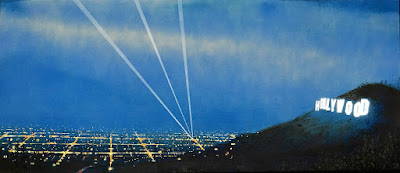ARTIST PROFILE: James David Thomas
“Imagine Euclid standing before the horizon and devising geometry, counting, which is a way to know the landscape. The city grid, for example, is painting people, their activities, and record.”
In his Urban Archeology painting series in particular, James David Thomas plays the Euclidean role, observing from on high the shimmering lights and criss-crossed streets of Los Angeles, all signs of the human element save flesh and blood themselves. Recalling the quality of light of painters such as Camille Corot, Gustave Courbet, and Charles Daubigney, Thomas delights in the depiction of landscapes in a twenty-first century world increasingly absorbed into the digital and the mechanical. Wide-open, broad, and sweeping, as our own personal worlds become smaller and smaller, Thomas's scenic views relate his love of nature and the pastoral, fighting what may seem like a foregone conclusion as the environment becomes more and more, in the artist's own words, “marginalized.” And indeed, his series High Gain—Hollywood remarkably demonstrates this tension between the urban and the rural; consisting of blue night skies interrupted by the glowing, ubiquitous Hollywood sign, the presence of humanity is inescapable in the forms of wood and steel but also in the light pollution that artificially brightens the Los Angeles sky.
High Gain #32
2014
Oil, gold leaf on panel
16" x 60"
Thomas comes by his love of landscape honestly. After a childhood spent in rural areas, the flatness and clarity of the Mojave Desert, he made himself at home in Los Angeles, where the interaction between humans and nature, celebrity and the ordinary, served as his inspiration. High Gain—Hollywood reflects the ambivalence that is the life of an Angeleno; referring to the amount of reflectivity of a screen, the term “High Gain” also functions for Thomas as a metaphor for the “money” and “glamour” of the city—a rueful term that sums up Thomas' feelings about the shiny, artificial quality of Los Angeles and how that quality interacts with the landscape surrounding the gleaming spires. Adding to the dualistic nature of his works is his use of gold leaf, which he applies as highlights to emphasize the unnatural, out-of-place quality of light he sees in the city skyline. He cites Richard Diebenkorn as having been a source of knowledge in the technique of working at a distance, while Los Angeles native Peter Shire taught him to “work smart.”
Thomas repeatedly stresses the importance of appreciating and enjoying nature as opposed to our screen-filled, increasingly indoors-y lives. And he has committed both the macro and the micro of the world onto canvas: the former with his cinematic views of Los Angeles and the surrounding areas; and the latter with his Haiku series, where the ripples in water and passing shifts of light on fish scales are captured with intimate, precise detail. When asked what he aims to evoke in his practice, Thomas replied: “A reverence for beauty as a worthwhile concept.” While his works don't feature faces or bodies, they are hardly shying away from the figurative. By depicting the effects of humanity on an ever-changing landscape, Thomas paints a portrait of humanity and human activities that sends a more powerful message than any portrait could convey, and challenge the viewers' notions of what beauty can, and should mean, in a rapidly-developing world.
Between Heaven and Earth
2014
Oil, gold leaf on wood
48" x 24"


Humanity without humans...interesting! I like the work. Nice write up.
ReplyDelete